#Lord Mountbatten and The Partition of India
Explore tagged Tumblr posts
Text
The Historical Significance of India's Independence Day
What historical event fascinates you the most? Some occasions become imprints in our psyche never to fade again. Incidents of historical importance are turning points in the life of a country and its people. The occasions of utmost importance which give immense pleasure acquire the stature of a religious festival. People and the network of a country get involved in celebrations. This is the…
#15 August#26 January#Ancient India#Constitutent assembly#Constitution of India#dailyprompt#dailyprompt-2108#Freedom struggle#Independence day#India#It took 2years 11 months and 7 days to complete#Life#Lord Mountbatten and The Partition of India#Mountbatten#writing
0 notes
Text
The Crown fact-checked. Part 1/60
Before we begin I have to say a few words:
I understand that The Crown is a work of fiction and my goal is not to say "It's all lies!", we know it is full of stuff that has never happened, I just want to "do my own research" and see which facts were changed
I will try to be as unbiased as I possibly can. I can't promise you will like my stuff or agree with me, but my thoughts are just my thoughts, you can always decide for yourself
This being said, let's start our journey
Season 1. Episode 1. Wolferton Splash

King George's VI illness
The Crown's opening scene is that of the king spitting blood and coughing heavily. This theme of illness is recurring for the rest of the episode.

King George VI was a heavy smoker. The cigarettes were rather cheap after war and it is no wonder he developed such an unhealthy habit. Note: i phrased it badly but he started smoking much earlier than after the war ended, the cigarettes were just cheaper so it was even easier for him to get access to smoking.
Due to his smoking he had a lung cancer and coronary artery disease. Both of his illnesses appeared in the series.
2. Prince Philip renounces his royal titles
The series is true to the reality here. On the eve of his wedding to princess Elizabeth Prince Philip renounced his "foreign titles" of Greece and Denmark and was styled as "His Royal Highness, Prince Philip, the Duke of Edinburgh, Earl of Merioneth, and Baron Greenwich of Greenwich in the County of London"

3. King stutters
It is no surprise to anyone who has ever watched "The King's Speech". King George stuttered ever since he was a child and attended speech therapy to get rid of it. He almost get rid of it and it is hard to notice it in his public speeches. You can listen to this if you're interested, the real speech King George VI delivered on September 3rd, 1939 addressing Britain's involvement in World War II.
youtube
4. Prince Philip gave up smoking because princess Elizabeth couldn't stand it
As any loving daughter would be, princess Elizabeth was preoccupied by her father's health. Seeing that smoking did not do him any good, she insisted prince Philip should give up the habit. He did and some sources state he didn't smoke once after his wedding day.

5. Limericks
As fun as it may sound the king was fond of dirty limericks. However The Crown faced a controversy as the king says the word "cunt" in the opening episode.
The full limerick is as follows:
There was an old Countess of Bray,
And you might think it odd when I say,
That despite her high station, rank and education.
She always spelled "Cunt" with a K!
6. Princess Margaret at princess Elizabeth's wedding
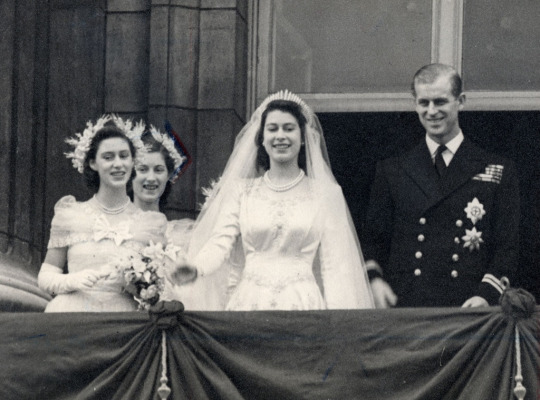
Princess Margaret was one of princess Elizabeth's bridesmaids. However she was shorter than her sister (Elizabeth was 163 cm tall, Princess Margaret was 155 cm).
7. Winston Churchill at princess Elizabeth's wedding. I Vow To Thee My Country
He and his wife attended the wedding and, in fact, caused a "false alarm" of applause by their arrival as everyone thought it was the princess who was cheered with such an enthusiasm.
However I Vow To Thee My Country apparently never played upon his arrival. But This song is indeed regarded as synonymous with Churchill, and it played at his funeral.
youtube
8. Hatred towards Mountbattens
Lord Louis Mountbatten was the last Viceroy of British India. In 1947 the partition of Pakistan was inevitable but it resulted in a blood bath. Million was killed, 15 millions were displaced.
Churchill was unsatisfied with Mountbatten's hurry to operate the situation and called it "a shameful flight" which was shown in The Crown.
9. Peter Townsend
Group Captain Peter Townsend was an equerry to King George VI. He indeed had an affair with Princess Margaret, the king's youngest daughter.
A gross fact but may I remind you: he was 33 and she was 17 in 1947 when their romance presumably began. We will discuss it further in later posts.
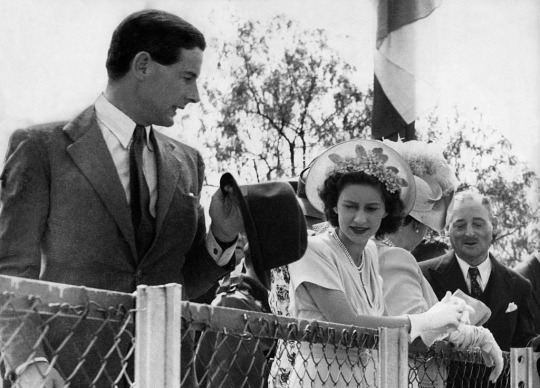
10. Nazis and the British Royal family
The British Royal family is notorious for its connections to nazis. We are not going to talk about Edward and Wallace (because we will talk about them later), but Prince Philip had four sisters, all of whom married members of the German aristocracy—three of those men became Nazis. One sister, Princess Theodora married Berthold, Margrave of Baden; they tried to keep their distance from Nazism.
His eldest sister, Princess Margarita, married Gottfried, the 8th Prince of Hohenlohe-Langenburg—a German aristocrat who joined the Nazi party and served in World War II. He was involved in Operation Valkyrie, the plot to assassinate Hitler in 1944.
Princess Cecilie, another sister, married German aristocrat Georg Donatus, Hereditary Grand Duke of Hesse. They joined the Nazis in May 1937, but died in a plane crash months later. At her funeral, Prince Philip marched with their relatives who wore Nazi uniforms.
His youngest sister, Princess Sophie, married Prince Christoph of Hesse, an Oberführer in the Nazi Party and a director in the Third Reich's Ministry of Air Forces. Sophie said in her memoir of Hitler, "I have to say here, that, although Chri [Prince Chrisoph] and I changed our political view fundamentally some years later, we were impressed by this charming and seemingly modest man, and by his plans to change and improve the situation in Germany."
It is worth mentioning that Philip served Britain during World War II and did not himself support the nazi regime.
11. The royal family was against princess Elizabeth's marriage to Philip
It indeed happened but for an unexpected reason. Royal courtiers said that prince Philip "was too funny and had too many gaffes".
12. Lilibet
Lilibet was a nickname for princess Elizabeth. It is said that it was given by Princess Margaret who couldn't pronounce "Elizabeth" at a young age. Now it is prince Harry's daughter name, what a sweet continuity.
i stand corrected: according to this source its origin can be different. Elizabeth used to call herself Lilibet when she was a toddler.
13. Waving
Royalty way much slower than everyone else. This waving is easy to recognise, you've seen it multiple times. It is supposed that this particular style is safer for articulations, and this can be one of the reasons they wave like they do.
youtube
14. Princess Elizabeth's passion for filming
Though it is not clear whether she liked filming herself, she was clearly fond of watching clips filmed by her family members as it was shown in "Queen at 90"
15. Princess Margaret smoking habits
Princess Margaret had a reputation of a heavy smoker. Rightfully so, as she could smoke up to 60 cigarettes a day. Allegedly she started smoking in 1952 after the death of her father (she was 21 at the time). Smoking excessively could be a sign of untreated depression and mental health troubles which we will discuss in later posts.
Side note: Margaret's smoking was first noticed in her late teens when she became famous on the party circuit for her turtle shell cigarette holder.

16. King's operation
The operation to remove the lung indeed took place at the Buckingham Palace.
When the King's chest was suspected as the cause of his ill health, Sir John called in Geoffrey Marshall, 64, an expert on lung diseases, and Sir Robert Arthur Young, 80, grand old man of British chest experts. X rays by Radiologist Peter James Kerley and others showed what seemed to be a growth in the left lung. Australian-born Brigadier Sir Thomas Peel Dunhill, 75, who enjoys the title of Sergeant Surgeon to the King, agreed that an operation was necessary. The doctors decided that another Welshman, Chest Surgeon Clement Price Thomas, was the man to do the surgery.
17. Princess Elizabeth's curtsy to her mother and grandmother
A sweet gesture and a nice tradition to show respect which lasts up until this day.
Here is a clip of prince Harry bowing to his grandmother followed by kissing her on both cheeks.
youtube
18. Churchill elected the second time
Churchill became PM for a second time on October 26th, 1951. Fun fact: it happened month away from his 77th birthday.
19. Princess Elizabeth's Commonwealth tour
As the following episode will show the prince and the princess were on Commonwealth tour in 1952 when they received the news of king George's VI sudden death. They were in Kenya when it happened.

20. Carolers at Sandringham
Even though I can't find any reliable source about this scene, it is a decent metaphor. The king who learnt he is dying welcomes villagers who offer him a crown.
They sing "In a Bleak Midwinter" which I highly recommend to listen to closely.
The poem was written by an English poet Christina Rosetti.
What can I give Him, Poor as I am? — If I were a Shepherd I would bring a lamb; If I were a Wise Man I would do my part, — Yet what I can I give Him, — Give my heart.
youtube
21. Prince Philip and Navy
Prince Philip's naval career began when he was 17. The Duke of Edinburgh’s active naval career ended as a commander in January 1953, after almost 14 years.
Despite his retirement from active service, Prince Philp remained both interested and involved in the Naval Service through official visits, patronage of, and association with, naval charities and clubs.
Useful links:
#british royal family#british royal fandom#brf#british empire#the crown#netflix#fact check#princess margaret#prince philip#lord mountbatten#winston churchill#king george vi#peter townsend#Youtube#queen elizabeth ii
12 notes
·
View notes
Note
In which world has India "occupied" Kashmir? Kashmir is a part of India which is severely affected by terrorist activity. Many were forced to leave their homes to settle in different parts of India (Kashmir pandits etc). How was that India's fault and not the fault of the country the terrorists came from?
Firstly, I want to make it clear that I do condemn what was done to Kashmiri Pandits. Secondly, I do believe that Kashmir is occupied (that does NOT mean that I don't understand that the geopolitical reality is complex), and that a plebiscite should have been conducted. And I believe that neither India nor Pakistan has been entirely innocent with regard to Kashmir.
My interpretation of the events described below (quoted from the linked articles), is that Kashmir is occupied. And no, they are not my only sources of information - other articles, the Kashmiri woman who came to speak at my university, and a friend of a friend who visited Kashmir and stayed there for a significant period of time (not as a tourist), are also sources of my information on Kashmir.
When India and Pakistan gained independence from British rule in 1947, the various princely rulers were able to choose which state to join. The Maharaja of Kashmir, Hari Singh, was the Hindu head of a majority Muslim state sandwiched between the two countries and could not decide. He signed an interim "standstill" agreement to maintain transport and other services with Pakistan. In October 1947 tribesmen from Pakistan invaded Kashmir, spurred by reports of attacks on Muslims and frustrated by Hari Singh's delaying tactics. The Maharaja asked for Indian military assistance. India's governor-general, Lord Mountbatten, believed peace would best be served by Kashmir's joining India on a temporary basis, pending a vote on its ultimate status. Hari Singh signed the Instrument of Accession that month, ceding control over foreign and defence policy to India. Indian troops took two-thirds of the territory, and Pakistan seized the northern remainder. China occupied eastern parts of the state in the 1950s. Whether the Instrument of Accession or the entry of Indian troops came first remains a major source of dispute between India and Pakistan. India insists that Hari Singh signed first, thereby legitimising the presence of their troops. Pakistan is adamant that the Maharaja could not have signed before the troops arrived, and that he and India had therefore ignored the "standstill" agreement with Pakistan. Pakistan demands a referendum to decide the status of Kashmir, while Delhi argues that, by voting in successive Indian state and national elections, Kashmiris have confirmed their accession to India. Pakistan cites numerous UN resolutions in favour of a UN-run referendum, while India says the Simla Agreement of 1972 binds the two countries to solve the problem on a state-to-state basis. There has been no significant movement from these positions in decades. In addition, some Kashmiris seek a third option - independence - which neither India nor Pakistan is prepared to contemplate.
The two countries fought wars over Kashmir in 1947-48 and 1965. They formalised the original ceasefire line as the Line of Control in the Simla Agreement, but this did not prevent further clashes in 1999 on the Siachen Glacier, which is beyond the Line of Control. India and Pakistan came close to war again in 2002. The situation was further complicated by an Islamist-led insurgency that broke out in 1989. India gave the army additional authority to end the insurgency under the controversial Armed Forces Special Powers Act (AFSPA). Despite occasional reviews of the AFSPA, it still remains in force in Indian-administered Jammu and Kashmir.
Today it remains one of the most militarised zones in the world. China administers parts of the territory.
Media in Indian-administered Kashmir are generally split between pro- and anti-secessionist. Local journalists work under strict curfews and also face threats from militant groups. Internet access is sporadic and text messaging services are regularly blocked.
In Pakistani-controlled Kashmir, the media are used mainly for propaganda purposes, mainly to highlight the alleged human rights violations in Indian-administered Kashmir.
Also, I think the following information is relevant too.
The Muslim majority in the princely state found the Maharaja’s reign authoritarian. In the words of Kashmiri author P.N. Bazaz, “Dogra rule has been a Hindu Raj.” Maharaja Hari Singh thought of independence because, according to American Indologist William Norman Brown, “He disliked becoming part of India, which was being democratised, or Pakistan, which was Muslim....”
On August 12, 1947, J&K petitioned India and Pakistan for a standstill agreement, which Pakistan signed but India refused, asking the Maharaja to send a representative for discussions. With every passing day, the Maharaja’s position became more precarious. As early as June 1947, about 60,000 ex-army men (mostly from Poonch) had started a no-tax campaign against the Maharaja. On August 14-15, Muslims in Poonch hoisted Pakistani flags, provoking the imposition of martial law and further angering Muslim subjects. Pakistan was sending warning notes to the Maharaja, one on August 24 reading: “Should Kashmir fail to join Pakistan, the gravest possible trouble will inevitably ensue.” The worst fears of the Dogra ruler came true when on October 22, Pakistan launched Operation Gulmarg by mobilising tribals from the North-West Frontier Province. About 2,000 tribesmen, armed with modern weaponry, raided Muzaffarabad. By the evening of October 23 they had captured Domel. Garhi and Chinari fell over the next two days. Then their main column proceeded towards Uri, and then, along the Jhelum river towards Baramulla, the entry point to Srinagar.
On October 24, Maharaja Hari Singh appealed to India for military aid to flush out the raiders. India obliged but not before the Instrument of Accession was signed on October 26. It limited India’s powers over the Valley to matters of defence, communications, and foreign affairs.
And this is from the Instrument of Accession:
Nothing in this Instrument shall be deemed to commit in any way to acceptance of any future constitution of India or to fetter my discretion to enter into agreement with the Government of India under any such future constitution.
4 notes
·
View notes
Text
26 January 2024 Republic day History | Springfield Public School Wishing Happy Reublic Day
On January 26, 1950, India officially became a sovereign, socialist, secular, and democratic republic, and the Constitution of India came into effect. This day is celebrated as Republic Day in India. The adoption of the constitution marked the culmination of India's struggle for independence from British rule.
Here is a brief historical overview leading up to Republic Day:
Independence Movement: The Indian independence movement gained momentum in the late 19th and early 20th centuries, with leaders like Mahatma Gandhi leading non-violent protests against British colonial rule.
Mountbatten Plan: Following World War II and increasing pressure from the Indian independence movement, the British government decided to grant independence to India. The last Viceroy of India, Lord Louis Mountbatten, formulated a plan for the partition of India into two independent dominions, India and Pakistan, which came into effect on August 15, 1947.
Constituent Assembly: After gaining independence, India had an interim government, and the Constituent Assembly was formed to draft a permanent constitution for the country. Dr. B.R. Ambedkar, a prominent jurist and social reformer, chaired the drafting committee.
Adoption of the Constitution: The Constituent Assembly finalized the Constitution on January 24, 1950. Two days later, on January 26, 1950, the Constitution of India came into force. The day was chosen to commemorate the "Purna Swaraj" declaration of independence by the Indian National Congress in 1930.
Republic Day Celebration: The first Republic Day was celebrated with great enthusiasm on January 26, 1950. The event included the hoisting of the national flag by the President of India, Dr. Rajendra Prasad, in the presence of other dignitaries. The celebration also featured a grand parade showcasing India's cultural diversity, military strength, and technological achievements.
Since then, January 26th has been observed as Republic Day in India, a national holiday celebrated with patriotic fervor and a reminder of the country's commitment to democratic principles and values.
Contact Us :- Mobile No:- +919466173015 , 9996900102 www.Springfieldschool.net

1 note
·
View note
Text
When was Bengal Partitioned?
British colonial authorities divided Bengal in 1947 to leave India. The last Viceroy of India, Lord Louis Mountbatten, and other British officials were the ones who partitioned Bengal. The Bengal partition date is July 9, 1905. The division was motivated by religious division into India and Pakistan, with Pakistan intended as a Muslim homeland.
0 notes
Text
Lord Mountbatten(1900-1979) was an influential British statesman, naval officer and colonial administrator who had a close relationship with the royal family.
He had a distinguished career in the Royal Navy, joining during the First World War and eventually being appointed Supreme Allied Commander of South East Asia Command for the Second World War. His dedication to service was remarkable.
Winston Churchill had a great admiration for Lord Mountbatten and held him in high regard.
In 1952, Lord Louis Mountbatten was appointed as the commander-in-chief of the British Mediterranean Fleet and NATO Commander Allied Forces Mediterranean. This allowed him to lead an important military force during this time period.
He acquired the position of First Sea Lord from 1955 to 1959.
Lord Mountbatten was an important figure in the NATO Military, serving as its chairman for a full year.
On 20 February 1947, Clement Attlee advised King George VI to appoint him as the Viceroy of India.
Lord Mountbatten was instructed to try and avoid the partition of India during Britain’s transfer of power, but he had permission to adjust his plans if necessary in order for Britain to exit quickly.
He arrived in India on 22 March 1947 and two days later, he took Viceregal Oath.
He had a positive relationship with Jawahar Lal Nehru, but he held different feelings towards the Muslim League due to their conflicting ideologies and goals.
Appointed Sir Cyril Radcliffe for drawing the line between India and Pakistan.
After much deliberation, Lord Mountbatten concluded that a unified India was an unattainable goal and resigned himself to the idea of partitioning it into two separate countries – India and Pakistan. This decision ultimately led to the creation of these independent nations.
#general knowledge#indian history#india#history#historyfacts#affairsmastery#india history#generalknowledge
0 notes
Text
The well of sacrifice
Basant Kaur was a survivor from Thoa Khalsa, not because she chose not to jump the well, but because the well was already full of dead bodies to drown her. “Many girls were killed. Then Mata Lajjawanti, she had a well near her house, in a sort of garden. Then all of us jumped into that... I also went in, I took my two children, and then we jumped in... the well filled up, and we could not drown…the children survived. Later, Nehru went to see the well, and the English then closed it up, the well that was full of bodies. “
0 notes
Text
Post # 106
Sir Cyril Radcliffe and his bloody lines.
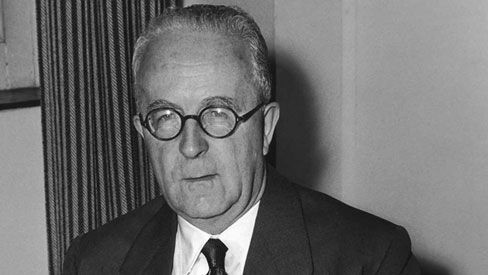
On 12th August, 1947, a British barrister, who had set foot in India only over a month back, who had never been to Asia before and who had never travelled east of Paris, presented to Lord Louis Mountbatten, the last Viceroy of British India, a map with two zigzag lines - one, 553 km long, from Gujarat to the southern tip of Jammu and Kashmir, and the other, 4096 km long, dividing the Bengal presidency into two. His name was Sir Cyril Radcliffe.

Together, these two lines created two new countries - the Republic of India and the Islamic republic of Pakistan (including East Pakistan which later seceded and became Bangladesh).
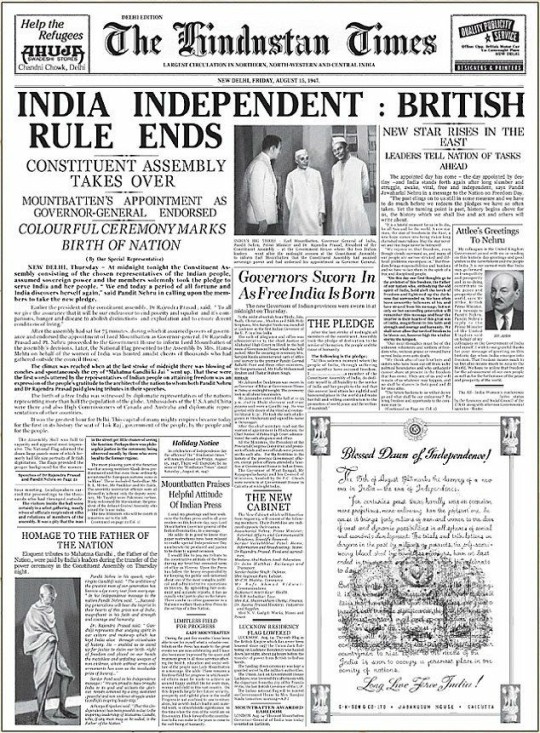
Lord Mountbatten waited five days before publishing the map on 17th August, 1947. He wanted the Independence Day celebrations to be done with - on 14th August for Pakistan and on 15th August for India. He probably expected trouble. Well, he was right. All hell broke loose!
These lines displaced 14.5 million people on either side of them. About 1 million people died in frustration-triggered riotings, pillage, rapes and looting. The scars have still not faded away. India and Pakistan are sworn enemies since. And will probably remain so for some time.
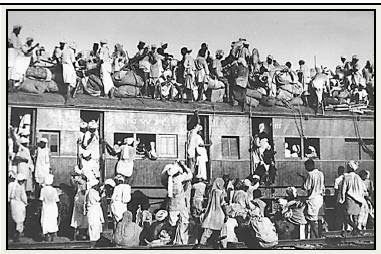
Together, these two lines are called Radcliffe lines and they represent the boundaries between India and Pakistan.
Sir Cyril Radcliffe is said to have been so appalled by the mayhem created by his infamous lines that he refused his salary of 3000 pounds (Forty Thousand rupees). And till his death in 1977, he maintained that he wasn't to blame for this fiasco, he did the best he could, he simply didn't have enough time. Therein lies a tale!
The details of the events that happened are somewhat like this:
After WW II, Great Britain realised that it simply didn't have the resources to control India any more, nor did it have the will to suppress its demands for independence. So, on 20th February, 1947, Prime Minister Clement Atlee announced that Britain would grant India full independence, latest by 30th June, 1948.
In March, 1947, a glamorous royal named Lord Mountbatten was sent to India as its last Viceroy. His mission was simple and clear: To hand over power to Indians, exit with as little damage to British reputation and if possible, avoid partition. But very soon, he realised that India was at a flash point, a truce between Indian National Congress and Muslim League was impossible and Partition was the only way out.
So on 3rd June, he shocked every one by declaring that the British would leave India on 15th August, 1947, about ten months before his deadline, and that the partition would be done based on religion-majority- demographics.
This was called the Mountbatten plan or the 3rd June plan. Mountbatten was clearly in a rush to exit India ASAP.

The British government back home ratified this decision by passing the Indian Independence Act on 18th July, 1947.
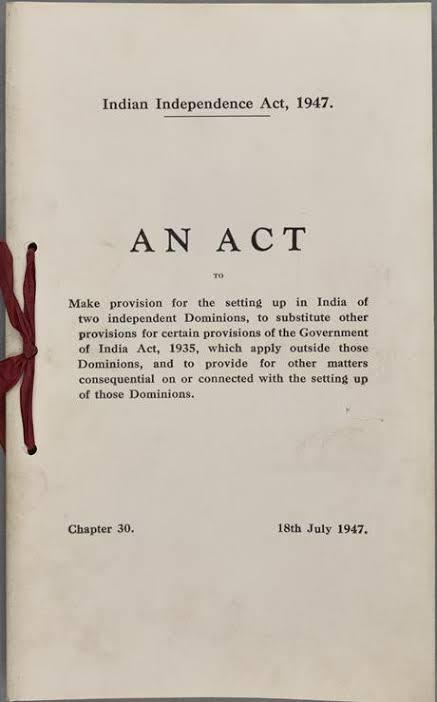
The only thing left to decide was who gets what! Some were simple. Baluchisthan and Sindh had 92% and 73% muslim population respectively. So they went to Pakistan. North West Frontier Province voted in a referendum to join Pakistan. Today, it is called Khyber Pakthunwa.
Princely states were allowed to decide who they wanted to accede to. They could even remain independent if they wanted. So both INC and ML wooed them. Over 560 princely states joined India. Three of them dithered. Junagarh and Hyderabad later joined India and integrated well. The third, Jammu and Kashmir, is a thorn in Indo-Pakistan relationships, even today, decades later. But that's another story. Books can and have been written on it.

All of these were relatively simpler. Punjab and Bengal, each with 54-55% Muslim majority were the tougher ones. Jinnah wanted them both. Nehru and Sardar Patel were adamant. Punjab and Bengal were tough nuts to crack indeed.
Enter Cyril Radcliffe, a complete outsider to this situation. Actually, the selection of Sir Cyril Radcliffe was made because he was a complete outsider and could not be unduly influenced by either the INC or the Muslim League.
He was appointed Joint-Chairman of two boundary committees - one to divide Punjab into East Punjab and West Punjab, and the other to divide Bengal into East Bengal and West Bengal. East Punjab had Hindu majority, West Punjab had Muslim majority. The vice-versa was true in Bengal.
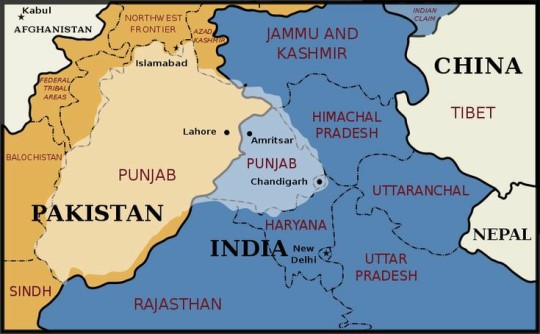
Each committee has two representatives each of INC and Muslim League. No one saw eye to eye. However, they had to distribute village, canal, field and drain - on the basis of religion.
Radcliffe had the responsibility of equitably dividing 450000 sq. km of territory inhabiting 88 million people. And he had just 40 days to do it. Maps were not accurate. Surveying was tough in the July heat in Punjab and Bengal. And Mountbatten would call him twice a day to remind him of his deadline.
So, he bent his back, did the best he could, drew the lines, made the maps, submitted them to Lord Mountbatten - on 12th August, three days ahead of schedule - packed his bags, went back to Britain, burnt his notes, refused his salary and swore never to return to either India or Pakistan. Till the day he died, he knew that he wasn't liked a lot in Punjab or Bengal.
That's the story of Sir Cyril Radcliffe and his blood-smeared Radcliffe lines.

There is a post-script to this story. We are talking about the independence of India and we haven't spoken a word about the guy most responsible for it - Mahatma Gandhi. While all this was happening, the Mahatma grieved in some corner of the country he loved, shocked by the way his dream was turning into a nightmare, not identifying with the "tryst with destiny" that his proteges seemed so cocky about, trying his best to douse the embers of religious hatred in different parts of the country or when tired, retiring to his ashram and spinning his wheel in misery. Less than a year later, an assassin's bullet would rip him apart and he would die with the words "Hey Ram" on his lips.
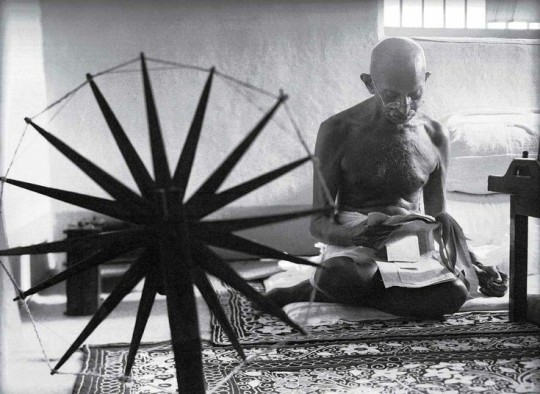
#cyril Radcliffe#Radcliffe lines#partition#indian independence#pakistan#bangladesh#lord mountbatten#india independence act#jinnah#nehru#sardar patel#east pakistan#india#british india
54 notes
·
View notes
Text

VICEROY’S HOUSE (Dir: Gurinder Chadha, 2017).
Viceroy’s House is a fact based drama detailing the events surrounding the Partition of India from British born Indian director Gurinder Chadha.
Set in 1947 Delhi during the dissolution of the British Raj. As the last Viceroy of India, Lord Louis Mountbatten (Hugh Bonneville) is to oversee the transition from British rule to Independence. India is a country divided, between those who wish the independent nation to remain intact and those who wish to establish the separate Muslim country Pakistan. Against this backdrop is the Romeo and Juliet-esq tale of Jeet (Manish Dayal) and Alia (Huma Qureshi) whose love is thwarted as he is Hindu and she is Muslim.
The Partition of India was a bloody mess at the hands of the UK government. As the film's postscript informs us "14 million people were displaced and one million Hindus, Muslims and Sikhs died". It is a dark episode in 20th Century British history rarely spoken of in the UK. For this reason, Viceroy's House is a difficult film to criticise, as it relays such an important story. Perhaps it can only be faulted for not depicting how truly horrific it was.
Hugh Bonneville is very effective as the beleaguered Mountbatten faced with the thankless and controversial task of dividing India. He is surrounded by a quality supporting cast of acting legends including Gillian Anderson, Michael Gambon, Om Puri and Simon Callow. As the star-crossed young lovers Manish Dayal and Huma Qureshi are both touching and appealing.
Director Gurinder Chadha is a talented filmmaker. Her feature is incredibly moving and made more powerful by the knowledge that it draws upon Chadha's own family history; her grandparents were among those displaced and her aunt starved to death on the migration.
It could be argued that Chadra's gentle approach to Partition does make a challenging subject more accessible for audiences. The fact that it addresses an issue largely untold in film is significant, however more palatable that issue has been made. The powerful tale may provide uncomfortable viewing for many, but do not let that dissuade you from watching this ultimately very moving film.
Check out my blog JINGLE BONES MOVIE TIME for a longer, more in-depth review of Viceroy’s House. Link below.
#viceroy’s house#gurinder chadha#hugh bonneville#manish dayal#huma qureshi#gillian anderson#michael gambon#om puri#simon callow#lord louis mountbatten#india#pakistan#britain#partition#partition of india#british history#raj#british empire#downton abbey#downton abbey movie#downton abbey film#movies#movie review#movie reviews#film#cinema#movie geek#british cinema#british film#every movie i watch 2019
2 notes
·
View notes
Text
UK Tribunal To Decide On Mountbatten Diaries From
UK Tribunal To Decide On Mountbatten Diaries From
UK Cabinet Office maintains most of the information from those papers is already in public domain (File) London: The personal diaries and letters of Lord Mountbatten, the last Viceroy of India, are at the heart of an ongoing appeal hearing in London this week, to decide whether they can be fully released for open public access. Judge Sophie Buckley is presiding over the First-Tier Tribunal…

View On WordPress
0 notes
Text
India was celebrating 50 years of independence and on the Queen’s itinerary was a visit to Jallianwala Bagh, the site in the city of Amritsar where in 1919 a British general ordered thousands of peaceful protesters to be shot, a massacre that was one of the bloodiest episodes of British colonial rule over India. The hope among many was that the Queen’s visit would finally bring about a long-awaited apology for colonial atrocities. But in the end, the apology never came.
“It is no secret that there have been some difficult episodes in our past,” said the Queen in her address the night before her visit. “Jallianwala Bagh, which I shall visit tomorrow, is a distressing example. But history cannot be rewritten, however much we might sometimes wish otherwise.”
When Queen Elizabeth was born in 1926, her grandfather was still the Emperor of India, which was under British rule for 200 years, but by the time she ascended to the throne in 1952, India had been independent for five years. At her wedding to Philip Mountbatten in 1947, the Queen was given a handkerchief by India’s best known freedom campaigner, Mahatma Gandhi, and it was said to remain one of her most treasured possessions.
The somewhat muted response to the Queen’s death in India reflects her complex position in a nation where the British monarchy is still seen as a lasting symbol of colonial rule that pillaged its lands for 200 years. India’s last viceroy before independence was the Queen’s distant cousin Lord Louis Mountbatten – also Prince Philip’s uncle – who oversaw the bloody partitioning of the country into the separate nations of India and Pakistan.
India remains the largest country in the Commonwealth, which is largely made up of former British territories and is still formally headed by the British monarch. After news of the Queen’s death broke, a national day of mourning was declared and all flags were lowered to half-mast.
“Her Majesty Queen Elizabeth II will be remembered as a stalwart of our times,” tweeted India’s prime minister, Narendra Modi. “She provided inspiring leadership to her nation and people. She personified dignity and decency in public life. Pained by her demise.”
But though multiple Bollywood stars sent effusive condolences over the Queen’s death on social media, there was otherwise little public outpouring of grief.
Jyoti Atwal, a professor of history at Jawaharlal Nehru University in Delhi, said that in India, the institution of the monarchy was still lambasted as a symbol of British rule. Hours before the death of the Queen was announced, Modi oversaw the renaming of Rajpath, a central avenue in Delhi that during the colonial period had been named in honour of King George V, Queen Elizabeth’s grandfather. Modi said Rajpath was a “symbol of slavery”, which would now be erased.
However, Atwal said that on a personal level, the Queen’s visits to India, particularly her first in 1961, had earned her much affection and admiration – many people can still recall watching her riding through the streets of Delhi in her royal coach buggy.
“The Queen represented the oppression of British rule and colonialism, but she was also viewed separately as a person, not just as a monarch, and people in India were very charmed by her visits, by that buggy culture,” said Atwal. “My mother still remembers the Queen’s visit in 1961; she was a child sitting in the front row when the Queen was travelling in the buggy. So it captured the public imagination even though it was clearly a remnant of the British Raj.”
Nonetheless, Atwal said, as the furore around the Queen’s visit to Jallianwala Bagh had demonstrated, in India there was a lasting expectation that the British monarchy should apologise for the injustices of colonial rule, which some view as an essential part of the process of decolonisation.
“There are large sections in India who still wanted an apology from the Queen and who still think there hasn’t been closure for the oppression of the Raj,” said Atwal. “The burden of giving that apology falls on the monarchy, not the prime minister or another member of the British government. So now that Charles is King, people in India will be expecting the apology from him.”
Since the the Queen’s death, there have also been calls for the return of the Koh-I-Noor diamond, one of the largest cut diamonds in the world, which sits in the crown of the Queen Mother and is on display at the Tower of London. The diamond, which was mined in India, has been the source of a decades-long dispute between India and the UK, with India saying it was taken illegally.
Over the weekend, the Indian MP and author Shashi Tharoor called its display in London a “powerful reminder of the injustices perpetrated by the former imperial power”. It is thought the crown bearing the Koh-i-Noor diamond will now be worn by King Charles’s wife, Camilla, the Queen Consort.
“Until it is returned at least as a symbolic gesture of expiation it will remain evidence of the loot, plunder and misappropriation that colonialism was really all about,” said Tharoor
5 notes
·
View notes
Text

Okay, so, here goes the original work regarding Homai Vyarawalla. Will be updating Prem Mathur soon.
Homai Vyarawalla: The First Indian Woman To Be A Photo Journalist
It was the time when India was undergoing structural changes finally preparing herself to draw a line to the 200 years of British Raj. It was only a few decades into the 20th century. Women were still shackled within the restrictions of the public and private and often discouraged available luxury of being educated. Though the participation of women picking down the barriers of discrimination, in the freedom struggle of India was extremely noteworthy, it was something, the male writers are narrators of Indian history have always somewhat omitted both knowingly or without intention, hence the amount of sacrifice and contribution to the freedom fight however did little in knocking down the walls of the existing social norms binding moment in the post independence era. The arena of photojournalism was then a male dominated sphere. Homai Vyarawalla was the first woman who dared to challenge the patriarchal nature of the domain, being the first woman behind the lens.
• Early Life:
Homai was born to a Parsi family staying in Navsari, Gujarat on 9th December 1913. Her initial years were spent in a Vyara near Surat. Then her family resolved to move to tardio, Mumbai and she completed her education with an Honors Degree from Bombay University. Homai valued the importance of education in her life and was always ready to dodge every bullet of social discrimination, often subjected towards woman, to continue her education. She was the only girl to complete her Matriculation among 36 students. Her parents, Dossabhai and Soonabhai Hathiram weren’t well educated, however left no stone unturned to encourage her to learn English thereby enrolling her in the grant Rd high school in Tardeo. Her attempts to receive proper education were often obstructed by social regulations imposed upon women. Due to her economy condition, she often had to move in and out of houses and travel long ways in order to reach the school. The stigma around the subject of menstruation used toasting her the most owing to her parsi roots. After completion of her Matriculation Homai pursued a degree in Economics from St. Xavier's College.
• Introduction To Her Profession: Homai met Maneckshaw Vyarawalla in 1926, the man who inaugurated the magical world of photography in her life at a railway station, who thereby continued to be an inspiration in our works of art. Homai primarily received mentorship from Maneckshaw to pick up the skills for photography. She also underwent a formal training and completed a diploma from the J.J School of Arts. They shared the Rolliflex of Maneckshaw, to develop their films in a dark bathroom. In 1941 Homai tied the knot with Maneckshaw, being fully aware of his mother’s displeasure regarding the current situation.
“In those days, Orthodox people did not want college educated girls for their sons. Especially those who had studied with boys,” she said.
• Career As A Photo Journalist:
All Homai started assisting Maneckshaw, who was working with The Illustrated Weekly of India and the Bombay Chronicle at that point. Some of her works even got recognition under the name of Maneckshaw Vyarawalla, as woman weren’t approved to be professional photographers then. The day to day activities of urban woman in Bombay where the foundations of our initial works. Her art captured there seems like no one.
In the wake of the Second World War and the events that followed by, Homai got to grab several opportunities to showcase her talent by capturing the political consequences of the war in India. The crisis had laid the participation of women in public domains, being the flag bearers of change, particularly in the era of post- independence. Both Parsi and British women in their public avatar were seen getting featured through her works.
The war also gave her a chance to permanently move out from Bombay. In 1942, the couple moved to Delhi. It was on outstanding move as it represented the initiation of her public life as a photo journalist. Homai and Maneckshaw began to work with the British High Commission which accelerated the success in Homai's career, for her familiarity the then Authoritiy, made her a regular at all events, irrespective of the nature. This was the start of the golden period in her career as a photo journalist.
• Golden Period:
Events that would later determine the history of the 20th century were on their way of happening when Homai had reached the zenith of her profession. The context on which she supported her artwork is therefore extremely significant for tracing her contribution to the Indian History. Always draped in a sari, accompanied by her Rolliflex camera, Homai was present at every significant event, archiving historical happenings and capturing renowned personalities like Jacqueline Kennedy, Queen Elizabeth, Eisenhower etc. Her penchant, however was for capturing India’s first Prime Minister Jwaharlal Nehru, a man, she considered to be extremely photogenic. Her favourite area of work was chronicling some of the greatest moments of Nehru's career and personal life including his initiation to the position of power, parties at the Delhi Gymkhana Club, the period when the Non-Alignment movement had picked up the heat among the masses and the 1955 Bandung Conference. Homai never lay the backdrop over public engagements turn out to be her definition. She kept distance between the public and private affairs. She went outdoors outdoors and utilised her outgoing nature for the sake of her creation. Her effortless display of her works in a series of black and white an order she's particularly enthusiastic about chose to be her medium of expression.
Some of the most important moments of her career consist of snaps of the Reception hosted by Lord Mountbatten at the Rashtrapati Bhavan on August 15th 1947, the meeting of Congress leading to the Third Plan, the decision of Partition, the flag hoisting at the Red Fort for the first time, funeral of Mahatma Gandhi, Dalai Lama entering India for the first time through Sikkim in 1956.
However, the earth below the pillars upholding India's structure was still volatile, so was homai's struggle for consistency in the male dominated environment. Her work was often overlooked for her male contemporaries got more credits for the prevalent patriarchal views in the society. In 1930, when Bombay chronicles published her first shot in of picnic party of the members of Women’s Club in Bombay, it was done under the name of her husband.
• The End of an Era:
Maneckshaw Vyarawalla had been a great influence on Homai’s career choices and their bonding lasted for 40 years. It was probably because of the heartfelt connecion the duo shared, Homai left her job behind with Maneckshaw's demise in 1969 and went to lead a life of seclusion and anonymity in Pilani with son Farouq. Her life there, adored simplicity of doing things, she did not have the opportunity to go for earlier. She enjoyed her life accompanied by women, something she didn’t go through earlier, due to her lack of connection with them.
“I was afraid of being with women. I only heard them talk about maid-servants, jewellery and make-up that I could never relate to. My world was so different. It was in Pilani that I understood woman can be good friends too and I shouldn’t be afraid of them.”
Homai Vyarawalla made sure she documented history through her lens. She had been giving several recognitions and awards including the second high civilian honour in India, the Padma Vibhushan in 2011. She passed away on 15 Jan, 2012. Her prized possessions are now in the Alkazi Fouundation for Arts and the National Gallery of Modern Art in New Delhi.
#study hard#studystudystudy#study tips#study blog#student#study#study aesthetic#study inspiration#study motivation#study notes#study space#studyblr#studying#studyinspo#studylustre#studyspiration#studyspo#studygram#handwriting#letterart#learning#lettering#researchbased#research#content writing#creative writing#writing#writing inspiration#writing prompt#my writing
5 notes
·
View notes
Text
am i supposed to feel sorry. for lord mountbatten. partially responsible for the partition. the man who played politics with the leaders of india regarding the partition like he was bouncing a tennis ball. the man who put a complete stranger who had zero knowledge of india in charge of drawing the india-pakistan boundary. the man who didnt want to deal with the fallout if people didnt like this boundary made by a complete stranger so he refused to reveal it until after the partition. when he would no longer be in power. so that at the time of independence villages along the border didnt know if they were in india or pakistan. and therefore had no way of making the choice to stay or move. which led to further riots and rape and looting once the boundary was revealed three hours after independence. that guy. really
27 notes
·
View notes
Text
The Shining, Part One: Redrum is the New Black, Mrs. Torrance
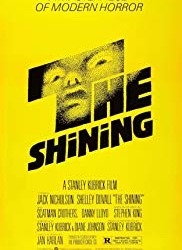
Before we go any further, I am very aware that The Shining was released in 1980, and thus should be exempt from the perusing of a blog dedicated to 1970s horror architecture. It’s probably the most-mentioned movie from friends asking me to cover a film, and I’ve been pretty dogged about sticking to my script with 1970s movies. But maybe I’m feeling generous, as we’re about to put this last decade to bed (and I never really figured out what to call it - the Twenty-Tens? Nope. The Tens? I don’t think so). Anyway, The Shining is one of my earliest favorite horror flicks, based on a book from one of my earliest favorite horror writers. And technically, Stanley Kubrick shot the bulk of his adaption of Stephen King’s 1977 book in the ‘70s. In fact, it could be argued (and will be in fact be argued forthwith) that The Shining is the last of the great 70s horror movies, and very different in tone and setting from what characterizes most 1980s horror films. What is this criteria, you ask? I’m so glad you asked!
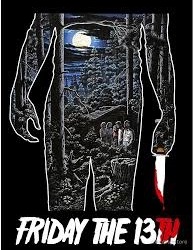
The great 1970s architecture horror flicks tend to be set on stately country manors (most of The Omen, the beginning of Don’t Look Now), stylish city apartments/lofts (Audrey Rose, Sisters, Profondo Rosso), or otherwise sophisticated urban or bucolic location, such as a dance academy (Suspiria). In contrast, many of the iconic 1980s horror flicks are set in manufactured wilderness (the Friday the 13th and Sleepaway Camp franchises), or safe suburbia (the Poltergeist and Nightmare on Elm Street franchises). These are spaces for children and teenagers, with nary a cocktail tray or curated window treatment in view. I’m pretty sure the transformation occurred because the target audience shifted to that age demographic, but it also does speak of the 1980s flavor of paranoia versus the 1970s psychosis. The 1980s were all about outsiders (slashers/monsters) attacking safe traditional spaces, where the settings of 1970s horror flicks were somewhat sinister themselves in their old-world elegance.
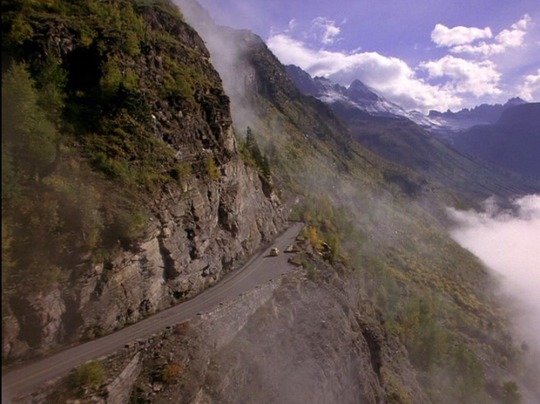
And speaking of sinister, Kubrick and cinematographer John Alcott did a wonderful stitch-up with the opening vista. Ariel shots from a helicopter above Going-to-the-Sun Road in Montana’s Glacier National Park are cobbled together with a wide view of Oregon’s Timberline Lodge, which served as the exterior shots of the fictional Overlook Hotel. I shall pause here to note that these endeavors, both park and hotel, exist courtesy of FDR’s Works Progress Administration. I first visited Timberline Lodge almost exactly 18 years ago while spending the Thanksgiving holiday in Hood River with my sis, bro-in-law, and nephew, and got to visit Glacier for the first time this past September (a lovely side trip after my brothers-in-laws’ wedding), and I gotta admit, I find nothing scary about democratic socialism. The WPA was responsible for providing work and hope to a lot of desperate people during the Great Depression, and leaves as its legacy some of our loveliest landmarks in America.
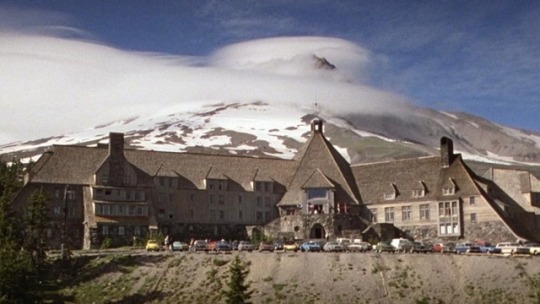
In contrast, the Stanley Hotel in Estes Park, Colorado was Stephen King’s inspiration for the Overlook. The Stanley was built by Freelan Oscar Stanley, of Stanley Steamer fame. Stanley the Steamer decided the local accommodations (where he fully recuperated from tuberculosis) were a bit too “rustic,” and the social scene too “relaxed,” so he built himself an exclusive enclave for the rich. Bully for you, Freelan.

The Overlook Hotel existed mostly as a set in Elstree Studio in England. Kubrick and production designer Roy Walker purposely set out to make the Overlook an amalgamation of bits and pieces of real hotels, rather than giving it one single design aesthetic. The red men's bathroom was modeled on a men's room in the Biltmore Hotel in Arizona (often credited to Frank Lloyd Wright, but in fact designed by his student Albert Chase McArthur).

The Colorado Lounge (that serves as Jack’s writing studio) was based on the lounge of the Ahwanee Hotel in the Yosemite Valley. The set of the Colorado Lounge ended up burning down; apparently, the fire was caused by the intense wattage of the set lights needed to make the interiors appear day-lit from sun reflected off the snow.

The Overlook also does not follow any laws of physics: rooms that should be wholly interior have windows, and hallways and floors don’t make any sense directionally-speaking. This disorientation helps to build the feeling of disquiet and unease in the early scenes. There’s a really worthwhile analysis of this and other Kubrick krazy-ness on YouTube by Rob Ager.
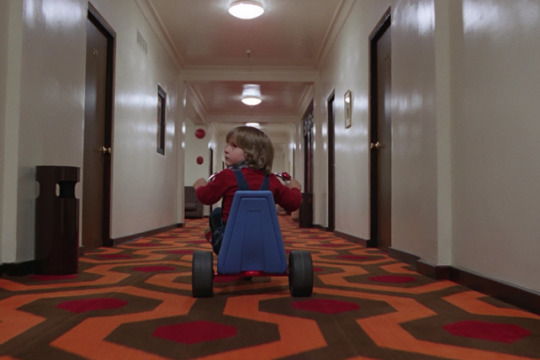
Before we break, here’s one last thing to chew on: the iconic carpet that Danny spins down on his Big Wheel was created by David Nightingale Hicks, the hot designer of the Swinging Sixties. The carpet wasn’t commissioned for the film, but in fact was in existence for about a decade prior. That particular pattern of brown, magenta, and orange is now licensed as Hick’s Hexagon, and you can buy a square for your own pad. Or (the more affordable option) you could just get a pair of socks. Kubrick was already familiar with Hicks’ work, though. The filmmaker featured the Chelsea Drugstore in a Clockwork Orange, a space designed by Hicks and the architectural firm he worked with (Garnett Cloughley Blakemore). Here’s a weird rabbit hole I fell down while researching: Hicks was married to Lady Patricia Mountbatten, the daughter of Louis Mountbatten, aka the First Earl Mountbatten of Burma, aka the last British Viceroy of India, and the man who oversaw the partition of that country into a separate Muslim state of Pakistan. It can be reasonably argued that Mountbatten’s clumsy transition to partition hastened the deaths of thousands during that period, as Hindus and Muslims scrambled to establish themselves in friendly territory. The bloodshed continues today in the two countries’ battle for control of Kashmir. Maybe something to ponder in concert with the image of an ocean of blood spilling from the elevator onto the brightly patterned floor? Another fun fact: Lord Mountbatten was assassinated by the Provisional Irish Republican Army 40 years ago.
Well, um, on that cheerful note, here’s to 2020! To be continued...
4 notes
·
View notes
Text
India’s 73rd Independence Day

MICA celebrated Independence day today with full enthusiasm and patriotism. MICA’s President, Dr. Shailendra graced the occasion by unfurling the tri colour and by reciting hindi poetry.
Our PGP1 and PGP2 students had prepared cultural prepared cultural program wherein they recited their own poems, sang patriotic song, danced with full enthusiasm and make sure that every MICAN is proud to be an INDIAN.
On this day today, let us know more about our struggle for freedom :
In 1757, British rule began in India which was followed by the victory of English East India Company at the Battle of Plassey and gained control over the country. East India Company took control in India for almost 100 years and then British crown replaced it via Indian Mutiny in 1857-58. During World War I, the India Independence movement was started and it was led by Mahatma Gandhi who advocated the method of nonviolent, non-cooperation movement which was followed by Civil Disobedience movement.
In 1946, the Labour Government, the exchequer of Britain thought of ending their rule over India because of their capital loss during World War II. Then, British Government in the early 1947 announced to transfer all powers to the Indians by June 1948. But the violence between Hindu and Muslim was not decreased basically in Punjab and Bengal. In fact in June 1947 several leaders like Pandit jawahar Lal Nehru, Mohammad Ali Jinnah, Abul Kalam Azad, B.R Ambedkar etc. agreed for the partition of India. Millions of people from different religious groups started finding places to reside. And due to this approx 250,000 to 500,000 people died. On 15 August, 1947 at midnight India got independence and was concluded by the Jawahar Lal Nehru speech "Tryst with destiny".
The British Prime Minister Clement Atlee on 20 February, 1947 declared that the British rule in India would end by 30 June, 1948 after which the powers would be transferred to responsible Indian hands. This announcement was followed by the agitation by the Muslim league and demanding for the partition of the country. Then, on 3 June, 1947, British Government declared that any Constitution framed by the Indian Constituent Assembly which was formed in 1946 cannot apply to those parts of the country which were unwilling to accept it. And so on the same day that is on 3 June, 1947, Lord Mountbatten, the viceroy of India put forth the partition plan which is known as Mountbatten Plan. The Congress and the Muslim league accepted the plan. Immediate effect was given to the plan enacting the Indian Independence Act 1947.
On 14-15 August, 1947, midnight, the British rule came to an end and power was transferred to the two new independent Dominions of India and the Pakistan. Lord Mountbatten became the first governor-general of the new Dominion of India. Jawahar Lal Nehru became the first prime minister of Independent India. The Constituent Assembly that was set up in 1946 became the Parliament of Indian Dominion.
India will celebrate its 73rd Independence Day.The Army, Navy and Air Force marched across the red Fort and the school children in colourful dresses do rehearsal in front of the dignitaries and audience present in the rehearsal.
The President delivers the “Address to the Nation" on the Independence Day event. Prime Minister of India unfurls the flag and holds a speech at the Red Fort. Several cultural programmes are held in the state capital Delhi by various schools and organisations.
People on Independence Day fly kites which symbolises the free spirit of India. Red Fort in Delhi is also an important symbol as on 15 August, 1947, the first Prime Minister of Independent India Jawahar Lal Nehru unveiled India's flag. Several people attend the flag hoisting ceremony in the city of Delhi which is a beautiful experience to watch. And some people watch patriotic cinemas; watch Red Fort ceremony in their houses at TV. Whole nation celebrate this day with full enthusiasm and with the spirit of patriotism.
We hope that you too celebrate the independence day with full patriotism and not let this emotion fade away.
Keep smiling :)
2 notes
·
View notes
Photo

Viceroy’s House (2017)
The final Viceroy of India, Lord Mountbatten, is tasked with overseeing the transition of British India to independence, but meets with conflict as different sides clash in the face of monumental change.
I had been looking forward to this film for what felt like ages. I went with high expectations and they were all met. It is an enjoyable and very moving film that shows you what has happened (the partition) and gives you a glimpse into what might have been had India stayed united. Partition of India was the biggest mistake of 20th Century.
youtube
#viceroy's house#Partition of India#Indian Partition#Pakistan#Bangladesh#Drama#History#Gurinder Chadha#Gillian Anderson#Michael Gambon#Hugh Bonneville#Manish Dayal#Simon Callow#Huma Qureshi#Om Puri#Edwina Mountbatten#General Hastings Ismay#Lord Mountbatten#gandh#mahatma gandhi#Muhammad Ali Jinnah#Jawaharlal Nehru#Historic#Film 2017#Movie review#India
1 note
·
View note